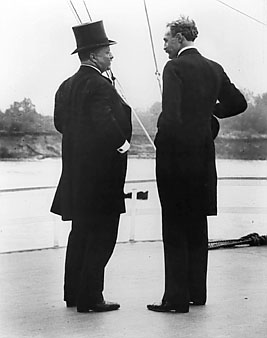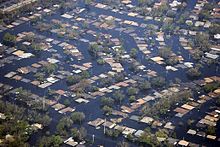
Civil defense or civil protection is an effort to protect the citizens of a state from human-made and natural disasters. It uses the principles of emergency operations: prevention, mitigation, preparation, response, or emergency evacuation and recovery. Programs of this sort were initially discussed at least as early as the 1920s and were implemented in some countries during the 1930s as the threat of war and aerial bombardment grew. Civil-defense structures became widespread after authorities recognised the threats posed by nuclear weapons.

Federal Emergency Management Agency (FEMA) is an agency of the United States Department of Homeland Security (DHS), initially created under President Jimmy Carter by Presidential Reorganization Plan No. 3 of 1978 and implemented by two Executive Orders on April 1, 1979. The agency's primary purpose is to coordinate the response to a disaster that has occurred in the United States and that overwhelms the resources of local and state authorities. The governor of the state in which the disaster occurs must declare a state of emergency and formally request from the President that FEMA and the federal government respond to the disaster. The only exception to the state's gubernatorial declaration requirement occurs when an emergency or disaster takes place on federal property or to a federal asset—for example, the 1995 bombing of the Alfred P. Murrah Federal Building in Oklahoma City, Oklahoma, or the Space Shuttle Columbia in the 2003 return-flight disaster.

The Congressional Budget and Impoundment Control Act of 1974 is a United States federal law that governs the role of the Congress in the United States budget process.

Robert Theodore Stafford was an American politician from Vermont. In his lengthy political career, he served as the 71st governor of Vermont, a United States representative, and a U.S. Senator. A Republican, Stafford was generally considered a liberal, or "Rockefeller Republican".

Emergency management or disaster management is the managerial function charged with creating the framework within which communities reduce vulnerability to hazards and cope with disasters. Emergency management, despite its name, does not actually focus on the management of emergencies, which can be understood as minor events with limited impacts and are managed through the day-to-day functions of a community. Instead, emergency management focuses on the management of disasters, which are events that produce more impacts than a community can handle on its own. The management of disasters tends to require some combination of activity from individuals and households, organizations, local, and/or higher levels of government. Although many different terminologies exist globally, the activities of emergency management can be generally categorized into preparedness, response, mitigation, and recovery, although other terms such as disaster risk reduction and prevention are also common. The outcome of emergency management is to prevent disasters and where this is not possible, to reduce their harmful impacts.

The Homeland Security Act (HSA) of 2002, was introduced in the aftermath of the September 11 attacks and subsequent mailings of anthrax spores. The HSA was cosponsored by 118 members of Congress. The act passed the U.S. Senate by a vote of 90–9, with one Senator not voting. It was signed into law by President George W. Bush in November 2002.
The National Response Plan (NRP) was a United States national plan to respond to emergencies such as natural disasters or terrorist attacks. It came into effect in December 2004, and was superseded by the National Response Framework on March 22, 2008.

The Robert T. Stafford Disaster Relief and Emergency Assistance Act is a 1988 United States federal law designed to bring an orderly and systematic means of federal natural disaster assistance for state and local governments in carrying out their responsibilities to aid citizens. Congress's intention was to encourage states and localities to develop comprehensive disaster preparedness plans, prepare for better intergovernmental coordination in the face of a disaster, encourage the use of insurance coverage, and provide federal assistance programs for losses due to a disaster.
The Disaster Mitigation Act of 2000, Public Law 106-390, also called DMA2K, is U.S. federal legislation passed in 2000 that amended provisions of the United States Code related to disaster relief. The amended provisions are named after Robert Stafford, who led the passage of the Stafford Disaster Relief and Emergency Assistance Act of 1988.

The National Emergencies Act (NEA) is a United States federal law passed to end all previous national emergencies and to formalize the emergency powers of the President.
The National Flood Insurance Act of 1968 is a federal law in the United States that was enacted as Title XIII of the Housing and Urban Development Act of 1968 and signed into law by President Lyndon B. Johnson that led to the creation of the National Flood Insurance Program (NFIP).
The Florida Division of Emergency Management (DEM) is charged with maintaining a comprehensive statewide program of emergency management. The division ensures that Florida is prepared to respond to emergencies, recover from them, and mitigate their impacts. DEM is responsible for the State Emergency Response Team (SERT) which is composed of various intergovernmental entities, volunteers, and the private sector. The division coordinates the efforts of the Federal Government with other departments and agencies of state government, with county and municipal governments and school boards, and with private agencies that have a role in emergency management. The Director is appointed by the Governor of Florida, and serves as an agency head. Kevin Guthrie currently serves as the Director. He was appointed by Governor Ron DeSantis in May 2021.
The Pets Evacuation and Transportation Standards Act (PETS) was a bi-partisan initiative in the United States House of Representatives to require states seeking Federal Emergency Management Agency (FEMA) assistance to accommodate pets and service animals in their plans for evacuating residents facing disasters. Introduced by Congressmen Tom Lantos (D-California) and Christopher Shays (R-Connecticut) on September 22, 2005, the bill passed the House of Representatives on May 22, 2006, by a margin of 349 to 29. Technically an amendment to the Stafford Act, it was signed into law by President George W. Bush on October 6, 2006. The bill is now Public Law 109-308.
The Cooperative Funds Act is a United States law, or series of laws, which authorized the United States Forest Service (FS) to collect donations from private partners to perform FS work. Contributions had to be voluntary, and by cash, check, or money order only. It was also stipulated that there could be no conflict of interest between the donor and the FS.

In the United States, a public health emergency declaration releases resources meant to handle an actual or potential public health crisis. Recent examples include:

Starting in 1876, and undergoing a series of name changes, the United States Forest Service grew to protect and use millions of acres of forest on public land. Gifford Pinchot, an early advocate of scientific forestry, along with President Theodore Roosevelt and conservation organizations, led the effort to manage forest for the public good.
Many countries around the world have civil defense organizations dedicated to protecting civilians from military attacks and providing rescue services after widespread disasters. In most countries, civil defense is a government-managed and often volunteer-staffed organization.

Public Law 113-2, containing Division A: Disaster Relief Appropriations Act, 2013 and Division B: Sandy Recovery Improvement Act of 2013 is a U.S. appropriations bill authorizing $60 billion for disaster relief agencies. The Budget Control Act of 2011 (BCA), had authorized only disaster spending and emergency spending to exceed established spending caps. While emergency spending is not subject to the caps in the BCA, spending for disaster relief is calculated by taking the average of the previous ten years disaster relief spending, excluding the highest and lowest spending years.

The Hurricane Sandy relief bill is a law enacted by the 113th United States Congress, in the aftermath of Hurricane Sandy.

The Federal Disaster Assistance Nonprofit Fairness Act of 2013 is a bill that passed in the United States House of Representatives during the 113th United States Congress. The bill would make religious organizations and religious non-profits eligible to receive federal funding for repairs and rebuilding of their facilities after a major disaster. The bill amends the Robert T. Stafford Disaster Relief and Emergency Assistance Act.








